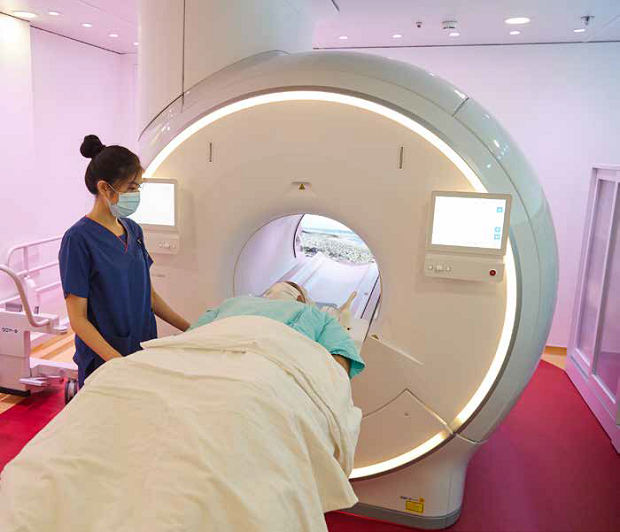
SGH goes to great lengths to keep patients safe and comfortable during an MRI scan to produce images of high quality.
Tattoos may be a no-no, but most pacemakers are now okay.
Gone are the days when patients with pacemakers are not able to undergo magnetic resonance imaging (MRI) scans because of the dangers posed by the strong magnetic and radio waves the machines use.
New-generation MRI machines are usually made with pacemakers and implants in mind. Other features may also be built in, including the ability to play music or videos to help soothe anxious patients who may feel claustrophobic lying in the tunnel-like space within the MRI’s doughnut or bore.
“With advances in MRI technology, it’s now possible to scan patients with implants, even those with certain pacemakers. We just need details about the implants, apply the appropriate workflow, and assign the right scanner for each job,” said Mr Zulhairy Zolkaffeli (below), Senior Radiographer, Radiography Department, Singapore General Hospital (SGH).

An MRI scanner is a large tube that contains powerful magnets to produce detailed images of the inside of the body. Almost any part of the body, including the brain and blood vessels, can be scanned. Patients fitted with a metal implant, such as a pacemaker, artificial joint or even an aneurysm clip, may not be able to undergo an MRI scan safely. Machines or implants that are not labelled MR Conditional will malfunction when exposed to the strong magnetic waves of an MRI machine. Even people sporting tattoos with metal fillings may feel the area heating up unbearably, while magnets in cochlear implants can move.
To address patient fears — a common issue — newer MRI machines have features to allay anxiety and claustrophobia. Patients with mild claustrophobia can have a mirror attached close to the face to reflect the view outside the bore instead of the tight space within. SGH’s newest MRI machine can create a relaxing atmosphere and the illusion of more space and light. Scenes of a beach, for instance, can be played, while the scanning room can be lit in the patient’s preferred colour or turned off.
Ear plugs can be worn or soothing music played to drown out loud noises that the MRI machine makes during a scan. Patients can also listen to their own playlist, or watch films streamed from their mobile devices.
It does not help that patients have to stay very still inside the bore — measuring 55 to 70cm in diameter — for good quality images to be produced. Each scan lasts about 30 minutes and can be much longer if the patient needs several body parts scanned. Most patients are able to overcome their anxiety when radiographers offer them relaxation options and assurances. “We have CCTV in the room, so if we see the patient in discomfort — flailing his arms or pressing the call bell — we will stop the scan immediately and find out what’s wrong,” said Ms Ong Zhen (below), Senior Radiographer, Radiography Department, SGH.

Information like whether the patient has implants and anxiety issues is logged into his SGH online medical file by his doctor when an MRI scan is being ordered. The procedure and safety-related questions are highlighted again in the letter that is sent to him to inform him of his appointment. The patient can watch a YouTube video, Understanding MRI, to know what to expect during the procedure. A third check is made before his scan, with the same questions asked to ensure he meets all the safety criteria. If the patient is suspected of having forgotten to declare something metallic in the body, the radiographer can use a metal detector to check.
As MRI scans become increasingly common, patients sometimes request their doctor for one, as they view MRI to be safer than x-ray and CT (computed tomography) since no radiation is involved. Moreover, MRI is able to pick up some cancers that CTs cannot; it is also able to detect abnormalities in soft tissues better. An MRI may also be ordered together with a CT as a supplementary tool.
Get the latest updates about Singapore Health in your mailbox! Click here to subscribe.













 Get it on Google Play
Get it on Google Play